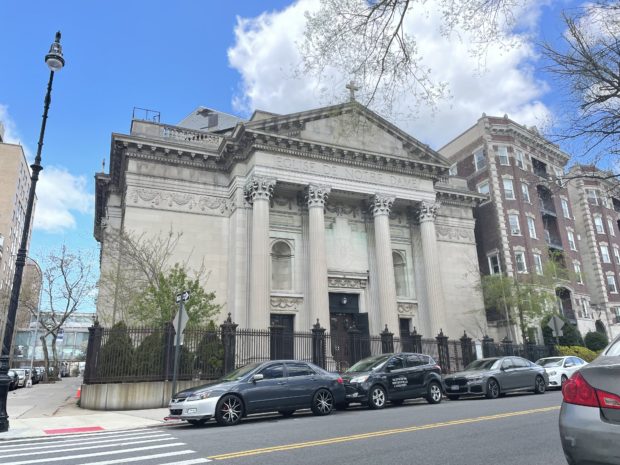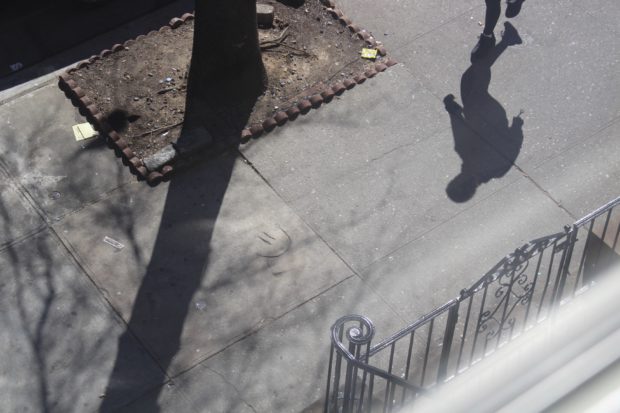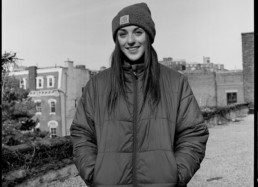The Blessed and Pink Dressed

I had visited Catholic churches before. Whether in Italy, Spain or New York, they always struck me with the same haunting silence.
Aside from the faint echo of monastic chants or organ chords, it was quiet. If I listened too hard, it was like I could hear someone whispering through the stone walls. Maybe believers heard Jesus in the whispers, and that’s why they sat so earnestly in the brown pews.
I couldn’t hear Jesus the way that they did so their prayers fell upon my arms and legs like chills. I entered the Church of Notre Dame in New York with only the expectation of echoes.
The church on 114th Street and Morningside Drive was hidden in plain sight, with a fence on the corner blocking it off from the noise of the neighborhood. A path through a small garden led either to the chapel where the priests said mass or to the rectory, where they lived.
As I entered the chapel, I saw one woman alone, her gaze fixated on the marble altar at the front of the room. . Her bright pink dress stood out from the clean, holy, untouched marble. With a mask on, she looked as if she could be an older cousin of mine, her black frizzy-wavy hair down her back, tan skin warm against the floral pink.
She arrived at the Tuesday service at least an hour earlier than everyone else. As she waited, she sat in a pew near the raised statue of the Virgin Mary. She looked between Mary and Jesus in reverence, muttering under her breath with her hands folded on her lap. It was like she knew God was coming.
Catholics believe that, in 1858 in Lourdes, France, the Virgin Mary appeared to a woman who would later be recognized as St. Bernadette. The New York church replicated this moment in a grotto in stone at the front of the chapel. The gray stone looked real, like someone had carved into the building itself to reveal its earthy interior. The grotto looked so natural against the stark white marble that it lured me into the scene of the Virgin’s apparition.
As she sat, the woman in pink held the same facial expression as the memorialized St. Bernadette–a combination of awe and longing.
While the priest gave his homily, the woman in pink was seated one row across from me, with her eyes laser focused on the book he was reading from. The Good Book, the word of God Himself, the Holy Bible.
She seemed to know every word to every prayer the priest spoke. I followed her to know when to stand up and sit down, and when to bow my head. But when she rose to take the Eucharist–the wine and bread that Catholics believe to be the real body and blood of Christ – I stayed in my seat. There are some moments that are only meant for true believers.
The woman in pink gracefully consumed Jesus’s body and knelt on the pew closest to Him to pray. As I sat in my pew, I tried to talk to God. But it felt like I needed someone to translate for me, like I couldn’t reach Him in the same way that everyone else could.
Her prayer was long. I could see in the folds of her face that she was fervently praying to God, faithfully asking for help and expressing her pious devotion. I wanted so badly for all of her prayers to be answered. But neither I, nor she, knew if they ever would be.
When she sat back down at the end of service, she started singing on cue with the other worshippers; out of tune, at a higher volume than the rest, but with the passion of someone who knew the song well and believed every word. It was a hymn about Jesus, but I couldn’t pick out the melody from her shouted notes.
She closed her eyes and remained in her seat. As I left the church, she was still singing.
Aria for the Bounty outside my window after Sharon Olds
Reflection Through Poetry
Aria for the Bounty outside my window
after Sharon Olds
Kate Cammell | kac2261@columbia.edu

I’d never noticed that there
are twelve of them on my block, trees
with branches like varicose veins, twisted
toward sky. Their nakedness
casting soft linear shadows
on the sidewalk. When
had their leaves fallen? I’d been
so damn busy in Autumn. I
can’t even remember
what color they turned. Perhaps
orange, but I couldn’t name
the hue. Maybe a shade like
campfire or papaya innards? But
now, I suppose, I’ll have time
to watch buds appear and to make
up for not knowing
which railings birds prefer
for perching on the wrought
iron fence across the street. I
can wake up and sit
in the light of my bay window
and notice the man wearing
a corduroy jacket buttoned
halfway up, his beret tilted
slightly—it’s important
to look crisp in a crisis
I think, letting ourselves pretend
in whatever way we
can to have control, sometimes
we need that. This morning
I made coffee and drank it
out of a pale pink Ikea
mug, then I did something
unbecoming of the New
Yorker I’d convinced
myself I am, I waved to people
rolling their metal carts
down the street, having just
pillaged shelves of the Harlem
Costco one block down. I
stood inches from
the glass, to be closer
to them and so I could
taste my own breath
bouncing back at me, a reminder
that I am alive. Every so often
a car honks their horn
at the nearby intersection and I’ll let
myself believe that they’re saying
hello to me. Saying we see you
by the window and we
are in this together. I’ve
started smiling back
at the face someone carved
in wet cement, now frozen
forever on the sidewalk below
my window. Yesterday, a
man strolled by after a successful
supply run, his cart bursting
with Bounty paper towel
packaged in groups of six, nestled
in plastic covering, ready
to provide—mental manna
for indefinite isolation. The man rested
his hand atop the package, perhaps
for stability but I saw
what I wanted. And
that was a gentle touch. Like
a measure reserved for loved
ones, and it was comforting
to think of being touched
as I looked out at a street
where people were speed-walking
to the safety of a home, their
Bounty in tow


